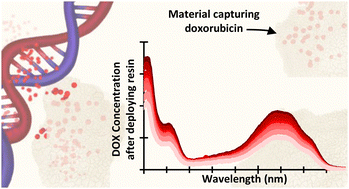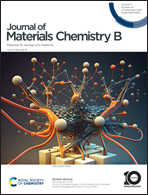Polymer–nucleobase composites for chemotherapy drug capture†
Abstract
Intravenous chemotherapy (e.g., doxorubicin (DOX)) is standard treatment for many cancers but also leads to side effects due to off-target toxicity. To address this challenge, devices for removing off-target chemotherapy agents from the bloodstream have been developed, but the efficacy of such devices relies on the ability of the underlying materials to specifically sequester small-molecule drugs. Anion-exchange materials, genomic DNA, and DNA-functionalized iron oxide particles have all been explored as drug-capture materials, but cost, specificity, batch-to-batch variation, and immunogenicity concerns persist as challenges. Here, we report a new class of fully synthetic drug-capture materials. We copolymerized methacrylic acid and ethylene glycol dimethacrylate in the presence of several nucleobases and derivatives (adenine, cytosine, xanthine, and thymine) to yield a crosslinked resin with nucleobases integrated into the material. These materials demonstrated effective DOX capture: up to 27 mg of DOX per g of material over 20 minutes from a phosphate-buffered saline solution with an initial concentration of 0.05 mg mL−1 of DOX. These materials use only the individual nucleobases for DOX capture and exhibit competitive capture efficacy compared to previous materials that used genomic DNA, making this approach more cost-effective and reducing potential immunological concerns.

- This article is part of the themed collection: #MyFirstJMCB


 Please wait while we load your content...
Please wait while we load your content...